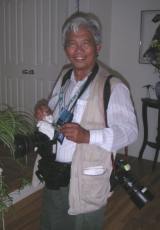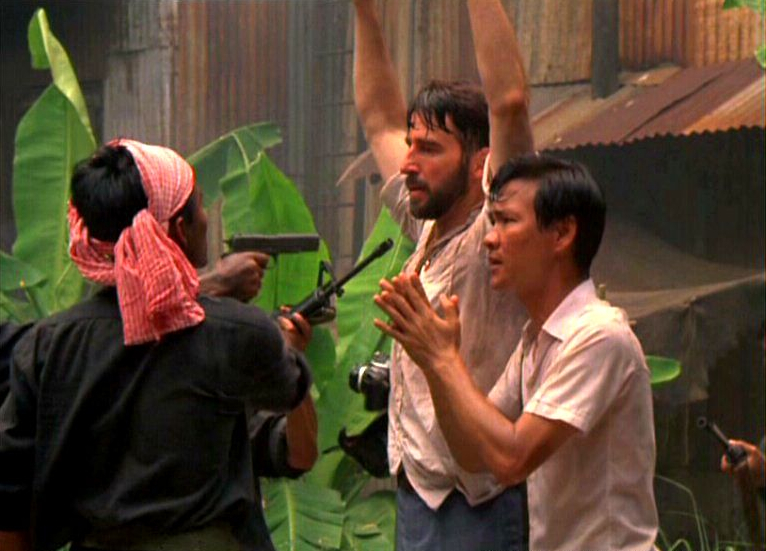Dith Pran dies
 Dith Pran’s life and tale of survival under Cambodia’s Khmer Rouge government became a movie. That movie THE KILLING FIELDS became a worldwide success, its very name coming to symbolize that vile China-backed Romantic-Communist regime, and Dith Pran used his celebrity to educate the world about that regime and become a constant burr in its saddle (he was quoted in the AP’s Pol Pot obituary, for example).¹ Dith Pran died yesterday.
Dith Pran’s life and tale of survival under Cambodia’s Khmer Rouge government became a movie. That movie THE KILLING FIELDS became a worldwide success, its very name coming to symbolize that vile China-backed Romantic-Communist regime, and Dith Pran used his celebrity to educate the world about that regime and become a constant burr in its saddle (he was quoted in the AP’s Pol Pot obituary, for example).¹ Dith Pran died yesterday.
THE KILLING FIELDS was one of the few serious movies made in the West from the late-60s until the end of the Cold War that can unabashedly be called anti-Communist. It’s primary subject was a Communist genocide and it’s the only “Vietnam War” film I can think of (it’s certainly by far the most significant) that is about the hell that US withdrawal created despite the assurances of peace-loving liberals at the time that US leaving the field in the Iraq Vietnam War would bring end the bloodshed. Oh, there’s a couple of asides in the film where characters say, close as I can recall, “after what the US did to them, I don’t think the Khmer Rouge will be very forgiving” or “the US underestimated the fury that tons of bombs can create” — lamely trying to suggest that the US created the Khmer Rouge.²
But the events that Dith underwent, and the magnitude of the Khmer Rouge genocide, are simply too overwhelming to withstand such spin. Nobody who’s seen the movie will ever forget — I will be vague to keep the surprise — a scene of Dith falling into an irrigation ditch. Apparently, according to this Dith obituary from AP (that I edited down from 35 inches to 15 to fit a hole), it was Dith who invented the term “killing fields.”
It was Mr. Dith who coined the term “killing fields” for the horrifying clusters of corpses and skeletal remains of victims he encountered on his desperate journey to freedom.
“That was the phrase he used from the very first day, during our wondrous reunion in the refugee camp,” Mr. Schanberg said later.
The film became a box-office success (about $70 million in current-dollar terms) and was critically and generally praised, e.g., being nominated for 7 Oscars, winning three, including Haing S. Ngor, also a Khmer Rouge survivor, as supporting actor for playing Dith. It’s got a 100 percent “Fresh” rating at Rotten Tomatoes (though that doesn’t mean quite as much for an older film as a current one). THE KILLING FIELDS also was one of the key films in the shaping of my critical sensibilities as a young adult — I have it #5 for 1984, which means more than it seems since all four films ahead of it are [also] all-time greats IMHO.
I saw THE KILLING FIELDS several times on frequent rotation in the late 80s on HBO and similar channels, and what I remember as intriguing me even then was how the film radically shifted gears and changed its central character at more-or-less the midway point, without ever losing interest. And while making it seem natural. Up until the fall of Phnom Penh, the film was essentially Sidney Schanberg’s war-correspondent story, with Dith being a supporting player in a story that could have been told by Carol Reed and Alec Guinness or Joel McCrea and Alfred Hitchcock. But then it becomes Dith’s tale of survival, with Schanberg reduced to writing letters in a few scenes that have a real “meanwhile, back at the ranch” feel and are effective for almost that very reason. THE KILLING FIELDS stayed with the more dramatic story of Dith and avoided the cliche of the American who fights back into the country to save his buddy, which is what happens often in the movies but never in real-life. Or as Roger Ebert put it in one of the reviews that first turned me on to film criticism:
[S]tories based on what the movies insist on calling “real life” … have a way of getting smoothed down into Hollywood formulas, so that what might once have happened to a real person begins to look more and more like what might once have happened to John Wayne. One of the risks taken by THE KILLING FIELDS is to cut loose from that tradition
I also remember to this day how absolutely gripping the film was, even though it was one of those “edumacational pictures.” When they’re trapped in the French Embassy, there is a scene that involves a developing photo that is as tension-filled as any thriller. And the scenes of Khmer Rouge Cambodia — moments like the reconciliation of some former bourgeoisie in the village, details like how to get meat (cow-vampirism and worse), and style touches like how a small wad of US dollars are lit and framed — are not, as Ebert says, “an insane parody of a one-party state.” They simply are “a one-party state,” as Pol Pot, following the instructions of his teachers Rousseau and Robespierre, declared Year Zero, emptied the cities and tried to create a nation of illiterate farmers, uncorrupted by urban life and cilivization. And hey … if 1/3 of Cambodia’s population dies, well … Jefferson said worse.³
Ngor, who was murdered in Los Angeles in 1996, told the New York Times during THE KILLING FIELDS’s theatrical run:
If I die from now on, OK! This film will go on for a hundred years.
An excellent epitaph for Dith Pran, who took a philosophically Buddhist attitude toward his imminent death. Like Anne Frank before him, his life became a major work of art that forever rebukes his persecutors. RIP.
——————————————————–
¹ The photo of Dith attached to this paragraph at the side (it happened to come up first on GoogleImage search for “Dith Pran”) was taken by Richard Factor, who was photographed by Dith for a New York Times story and, from the post that he wrote about it, apparently hadn’t known who he was, had neither seen nor heard of THE KILLING FIELDS or knew Dith’s story. I point this out not to ridicule Mr. Factor as uninformed, but to point out that even being the subject of a major movie won’t necessarily make you a celebrity, just a survivor.
² It’s a corrupt sophism so truly vile that I almost like it — the US supports Group X, therefore it’s responsible for the bad stuff Group X does; the US opposes Group Y, therefore it’s responsible for the bad stuff Group Y does. Which rather goes to show that the speaker’s thought process really is “Blame America, Whenever and Whatever.”
³ “My own affections have been deeply wounded by some of the martyrs to this cause (the French Revolution) but rather than it should have failed, I would have seen half the Earth desolated.”


Good post, Vic. I grew up in Long Beach, home of the biggest Khmer community outside of Southeast Asia, and seeing this movie in college (I think I had already seen it a few years before, but I was a little young to really understand it) made me cry profusely afterwards, thinking about what some of my friends and their families had been through. The movie’s not perfect, but it’s as good a testament to evils of communism as any.
Comment by Adam Villani | March 31, 2008 |
The subject matter MADE the film anti-communist, even though the filmmakers didn’t want it to be.
The most bizarre part of the whole film, for me, was the ending, when Dith Pran tearfully meets Sidney Schanberg again while John Lennon’s “Imagine” plays.
I was probably the only person in the theater thinking that a world with “No possessions… and no religion too” was EXACTLY what Pol Pot and the Khmer Rouge were trying to create!
Comment by astorian | April 2, 2008 |
The other day “Imagine” came on the radio and I actually imagined all the things he asked me to do. “No heaven” – no thanks. “No countries” — OK, then you get warlord maniacs like in Somalia. “No possessions” — well, that’s just annoying. “Hey, where are my pants?” “Oh, some dude came by and just took them. You don’t mind, right?”
Comment by Adam Villani | April 3, 2008 |
I’m the Richard Factor who took the picture above, and who isn’t being ridiculed in the footnote. I just wanted to add that:
1: I have nothing against ridicule! And I make an excellent subject of same, notwithstanding the disclaimer.
2: I’m not quite THAT ignorant. I had heard of (but not seen) the movie and was well aware of the story in general and the Khmer Rouge in particular. I simply didn’t know Dith Pran was the subject until he told me.
I was honored and surprised that my simple snapshot of Pran came up so quickly in Google.
Richard
Comment by Richard Factor | April 18, 2008 |